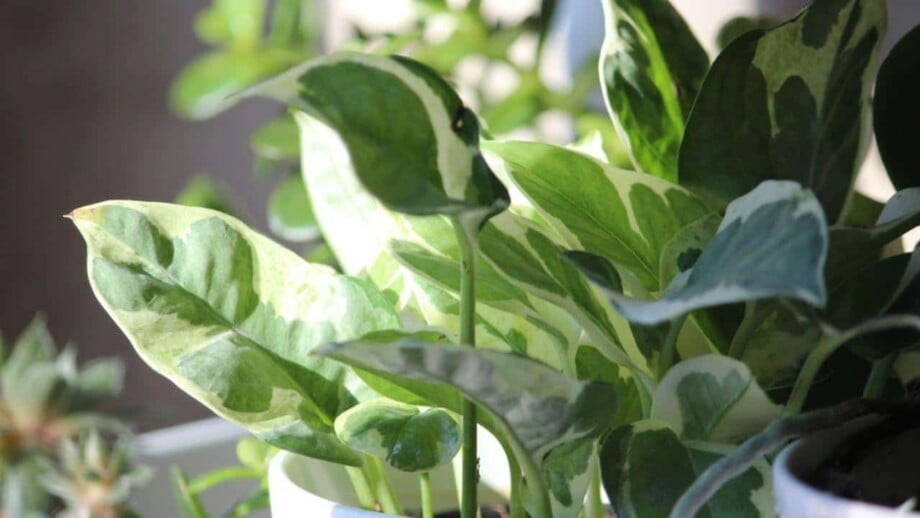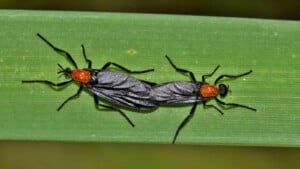Pearls and Jade’ pothos (also called variegated philodendrons or devil’s ivy) have variegated green leaves covered in gray, white, and cream streaks.
They are traditionally displayed as small potted plants or hanging baskets. This type of pothos is considered an easy-to-grow houseplant perfect for your indoor garden.
Here’s everything you need to know about the Pearl and Jade pothos.
Botanical Name: Epipremnum aureum ‘Pearls and Jade’
Common Name: Pearl and Jade, devil’s ivy, variegated philodendrons
Family: Araceae
Plant Type: Perennial, evergreen, vine
Hardiness Zones: 10a-12a USDA
Sun Exposure: Partial indirect sunlight
Soil Type: Moist but well drained
Soil pH: Acidic
Height: 6 to 10 ft long
Bloom Time: Spring and summer
Native Area: South Pacific

Pearls and Jade Pothos Facts
The pothos Pearls and Jade’s scientific name is Epipremnum aureum.
‘Pearls and Jade’ is named after its stunning white and green variegated foliage.
This type of pothos is one of the most lavish on the market. Unlike many believe, The pearls and jade pothos and the popular marble queen pothos were created in 2009 by the University of Florida. While these two pothoses may be related, they have different appearances. Pearls and jades are known for having thinner leaves and are much smaller than other pothos varieties, such as the golden pothos.
This type of pothos is a mutation from a marble queen pothos plant group. The pearl and Jade’s dazzling off-white tones and muted forest green color make it a marvelous display.
Since entering the houseplant scene in 2008, this plant has earned its status as a valued and adored Pothos cultivar.
Pothos plants are evergreen tree-climbing vines native to the Solomon Islands.

Pearls and Jade Pothos Care
Pearl and Jade’s pothos are known for their slow-growing process and easy-care reputation.
This pothos’s care is similar to most of its Epipremnum genus relatives, although some crucial differences exist.
Light Requirements
Unlike other pothos varieties, pearls and jade pothos does not tolerate low light conditions nor direct sunlight (as it will burn their papery-thin leaves). This type of pothos needs medium-filtered or bright indirect light.
Although this plant can survive short periods of low light conditions, it needs several hours of bright indirect light daily to keep its white variegation foliage.
The ideal place for this plant is directly in a north or east-facing window, but if that is not possible, a couple of feet back from south or west should work too.
Water Requirements
Like most pothos varieties, Pearls and Jade can withstand drought but enjoy regular watering. This plant should be watered when the top 1-2 inches of soil has dried. The exact watering frequency depends on the time of the year, season, or weather.
Water your pearls and Jade until the excess water runs out the drainage holes at the bottom of the pot. During fall and winter, you may water your plant once every two weeks; during spring and summer (or when the temperature is warm), you may need to water your plant once a week.
Soil Requirements
This variety of pothos needs well-draining soil. So buying a good quality potting mix is recommended. If you want to make your potting mix last, mix two parts of it and two parts of perlite to improve drainage.
Pearls and jade pothos do best when planted in airy, well-draining, and rich soil. This plant can do well in moist conditions but is susceptible to root rot when exposed to soggy soil. Pothos plants, in general, do well in different houseplant soils with additional fine moss, perlite, coco coir, and other additives like sand.
Besides acquiring a high-quality indoor potting mix, you can add additional coco coir and chunky perlite. These additions help with aeration and drainage and keep the plant’s roots healthy.
Humidity and Temperature Requirements
This type of pothos is a tropical plant and likes warm and slightly humid conditions.
For the most part, standard household temperature conditions are okay for these plants. Still, if you live somewhere dry, provide your plant with extra humidity to help it thrive with a humidifier or a pebble tray.
This plant likes 40% or higher humidity levels and is happily comfortable in 65-80º Farenheit sites.
The humidity is too low if your plant’s leaves have brown tips. You can mist your plant’s leaves in the morning to increase moisture and let the leaves dry out to prevent fungal diseases and mold.
Fertilizer
The Pearls and Jade Pothos benefit from balanced, water-soluble liquid fertilizer (for indoor plants) every two weeks at half strength from spring to fall(growing season).
During the winter/cold season, reduce fertilizer to once a month.
Although this plant benefits from liquid fertilizer, you’ll be pleased to hear that pearls and jade pothos are not heavy feeders, so you won’t have to fertilize it frequently. If you’re using a chuck-full potting mixture, you won’t have to worry about using fertilizer.

Pearls and Jade Pothos Propagation
Propagating this type of pothos is a fantastic way to grow new plants or expand your indoor garden.
Pearls and Jade pothos can be easily propagated by rooting the plant’s stem cuttings. It’s best to propagate your pothos during spring or summer since this plant is actively growing and can recover better.
- Using clean scissors, take as many cuttings as you’d like from a healthy pothos. Each cutting should have four to five nodes on the stem.
- Remove the bottom two to three leaves from each cutting so the bottom nodes are exposed along the stem.
- Prepare a container with clean water and place the cuttings so the nodes along the bottom of the cuttings are submerged while the top leaves are above the water’s surface.
- Place your cuttings where they can receive bright indirect light, and change the water once a week.
- After a couple of weeks, you should notice small white roots growing from the cuttings. Once the roots are two to three inches long, you can move the cuttings to the soil.
- When repotting, prepare small pots with well-draining soil, plant the new cuttings, and then water them well after planting. Place your cuttings where they can receive bright indirect light and keep the soil evenly moist for the first two weeks to help the new roots acclimate. After two weeks, you can begin to water your new plants as usual.
Pearls and Jade Pothos Common Problems
Like most pothos varieties, pearls and jade pothos are easy to grow, take care of, and generally problem-free.
However, they can suffer from occasional issues. Keep an eye out for any of the following signs:
Common Pests & Diseases
Pearls and Jade pothos are not particularly prone to diseases or pests, but when an infestation occurs, it’s likely to be common houseplants pests like spider mites, thrips, and fungus gnats.
If this is the case, gently rinse your plant thoroughly and let all the excess water drain fully before applying insecticidal soap.
Yellow and Curling Leaves
Yellow or curling leaves are a common sign of root rot.
Pull the plant out of the pot and look at the roots to fix this issue. The plant is either dead or dying if they are brown and mushy. Discard the whole potting soil and plant. Do not use this pot again until it sits in a ‘bath’ of one part bleach and nine parts water for half an hour to kill the root rot organisms.
Brown Spots
Brown spots suggest you’re overwatering your pearls and jade pothos.
Let your plant fully dry out, and plan a watering schedule.
If you’re watering your plant correctly and you see brown spots, ensure your pot has proper drainage, change your potting mix, and change to climate conditions that favor your plant.
Drooping Leaves
This is a common sign that your pearls and jade pothos plant needs to be watered.
While this may sound alarming, it’s not necessarily a cause for concern. This plant usually perks back up after a good watering.
Waiting until your pothos’ leaves droop a little before watering can be a helpful technique to avoid overwatering.
Just ensure you don’t let your pothos sit around with drooping leaves for long- if you do, your plant’s leaves will turn brown, and the roots will dry out.
Brown Leaf Tips
Brown leaf tips mean that your plant needs more humidity.
Try misting your plant’s leaves in the morning or placing your plant near or on top of a pebble tray.
Take a large tray, fill it with pebbles, and put water until just the top half of the pebbles are dry. Place the plant’s pot and saucer on the pebbles.
This technique creates a humid microclimate as the water evaporates.
Refill the water on the pebble tray often so it doesn’t dry out.
Pearls and Jade Pothos Toxicity
Pearl and Jade pothos may look harmless but are toxic to humans and pets.
For this reason, it should be kept out of reach for your four-legged friends and little ones.
Stomach ache, cough, vomiting, and dizziness are the common symptoms of Pearls and Jade Pothos toxicity. Domestic animals, like dogs or cats, may present drooling and have difficulty breathing.
In the case of Pearls and jade ingestion, seek medical attention immediately, or call the poison control center.
How can you prevent your pets from eating your Pothos?
Citrus
Citrus is a deterrent for domestic animals (especially cats). You can keep your pets away by using citrus fruit peelings such as lemons and oranges. Simply peel your citrus and lay it around the soil.
Spray the leaves
Instead of using fruit peelings, you can get some lemon juice or juice from different citrus and spray this onto the leaves to fend off your pet.
Pepper
You can shake a bit of cayenne pepper around your plants to repel your pets and some pests. Using Cayenne pepper is a controversial approach among pet owners, as some may not agree with this method.
Other Plant Guides from Planet Natural:
Types of Pothos: 15 Varieties to Consider Growing Today
26 Common House Plants That Are Perfect for Every Home
11 Best Indoor Plants of 2023 (Easy, Low-Maintenance Plants)











